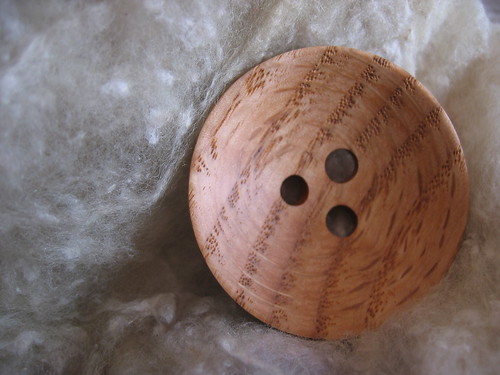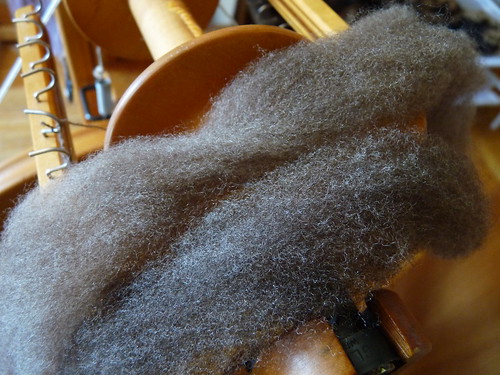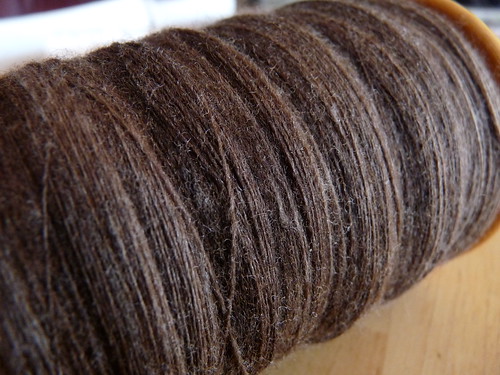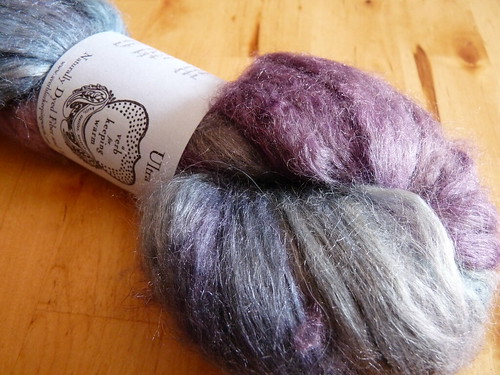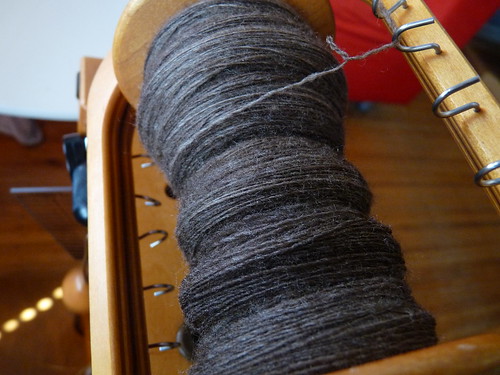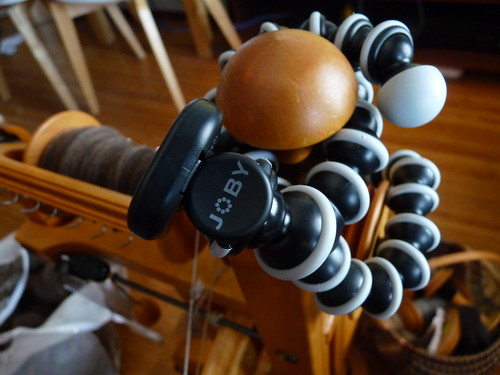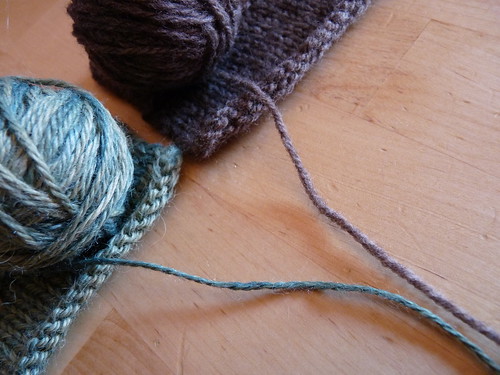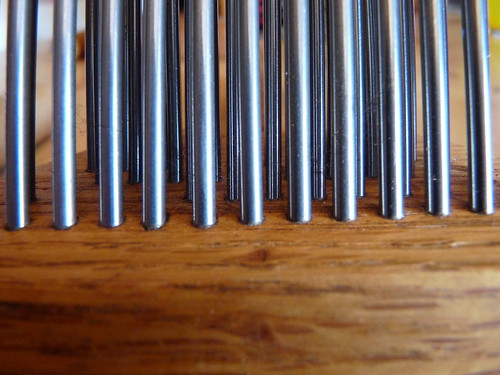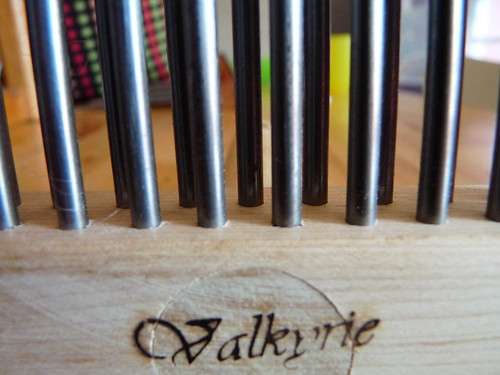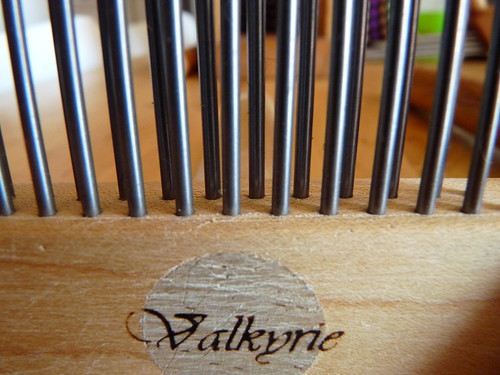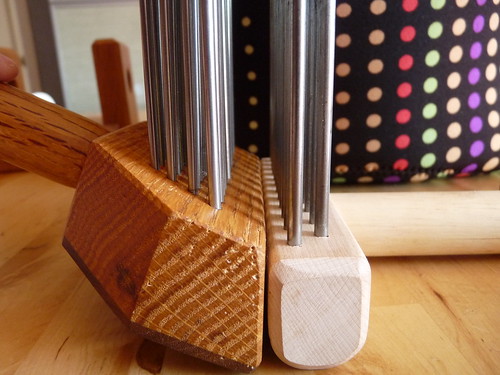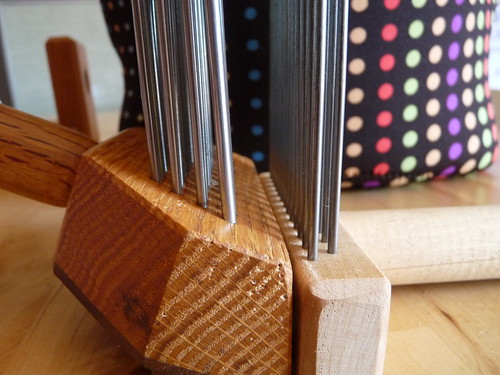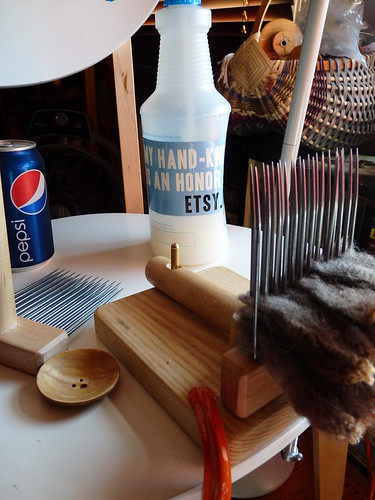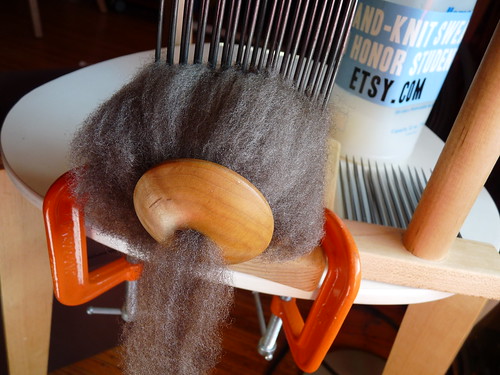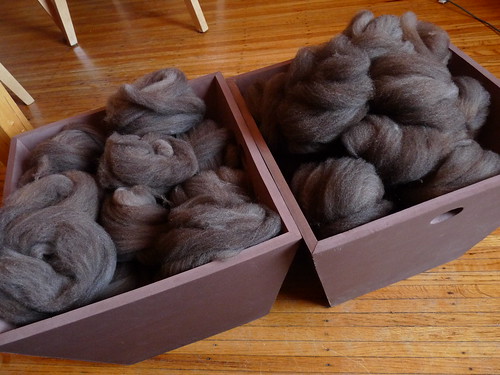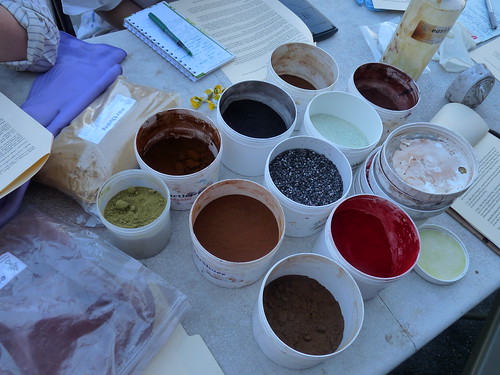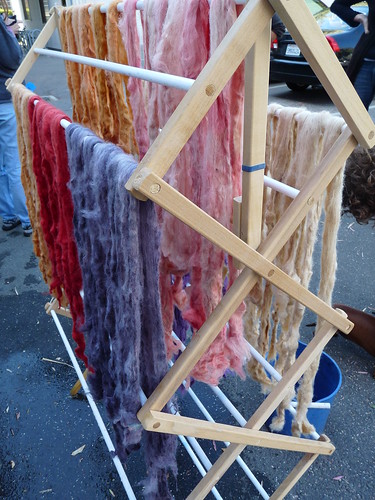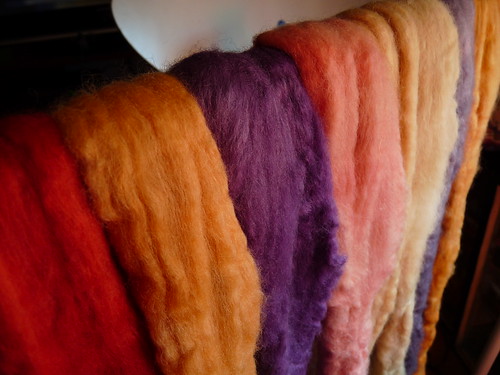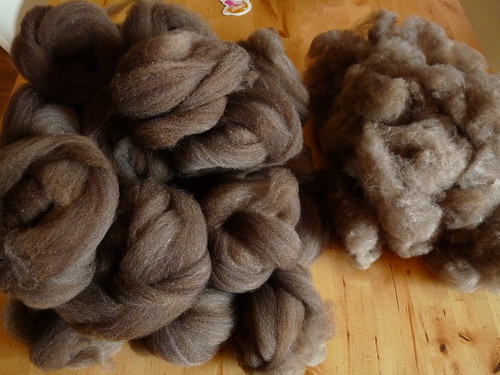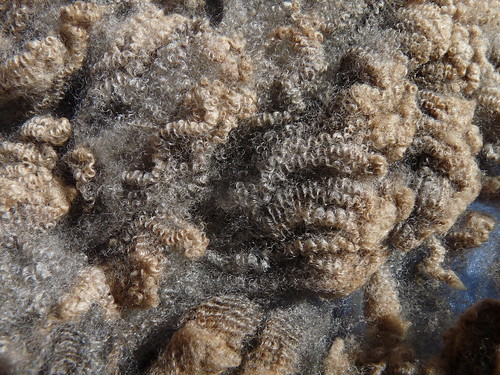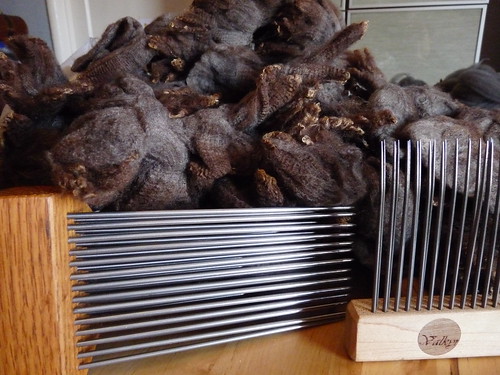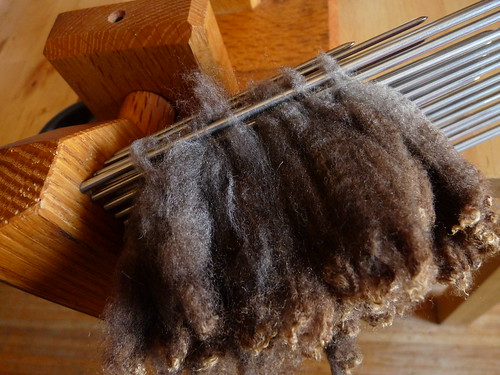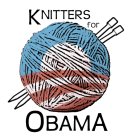I succumbed to a lot of distractions during the Tour de Fleece... hands down the best was attending the fleece judging prior to the Monterey Wool Show with Heather. She has a great writeup about the day as well. We met in person recently at Verb's Natural Dyeing 101 class, even tho I'd been reading her blog (I feel like I know so many people without ever meeting them in person, so it's always neat to get to do so.) She was kind enough to drive and we trekked it down early Saturday, coming into a room full of fleeces and a small clutch of attendees listening to (married) judges Wes and Jane Patton going over each.
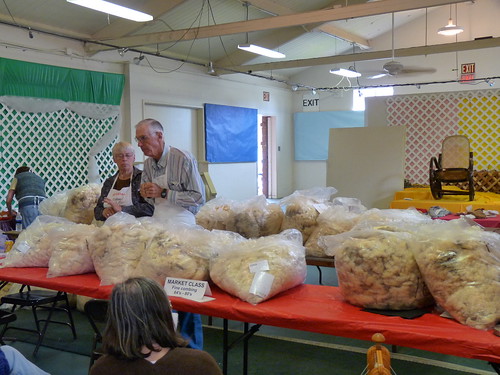
This was the second time I had attended a wool judging, the first was at Lambtown last year with about a third to half of the number of fleeces that were at Monterey this year. In addition to blood classes (market/white and colored wool, ranging from fine combing/64-80s down to common/40s) Monterey has judging categories for breed as well (cormo, merino, cvm, etc.). For me, I prefer the finer end of the spectrum and am lucky that there were so many excellent cormo, rambouillet and merino cross flocks in Northern California represented for me to lose it over.
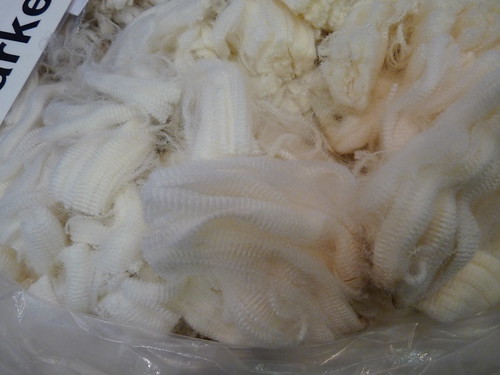
Goodness. Save me.
The thing is, I went to the judging because I had NO intention of buying more fleece and probably wouldn't attend the auction this year. (I can hear you laughing from here.) I went because I wanted to learn, and did... but fell in love left and right with color and hand while my brain was being stuffed with information. (too familiar, too soon)
Attending the judging does give a different perspective on buying the fleeces at auction later; I can also see a difference in the fleeces entered this year from last. Last year I fell for one of only three true black fleeces (not the dark brown tinted black, but honest to goodness black)-- color queens like me will flip seeing several up for bid this year. There were many more entries from fewer shepherds, and there seemed to be a lot of not for sale fleeces as well (several ribbon winners were shipped on back home and won't be at the auction.)
The thinking on this doesn't make sense to me, as the auction setting would provide the highest per pound price most shepherds could likely get (and they're able to provide the starting price per pound, so it could be returned later). I also didn't understand why several fleeces that were tender/had breaks were entered into the competition at all...

The up side of buying at a wool show that is judged is that these were culled and will not be available for sale-- the buyer knows that each fleece has been gone over and most likely will be sound. It's promising since you don't always know the shepherd or don't know someone who can vouch for them and you're not able to check the soundness of the fleece for yourself. For the seller who sends in a tender fleece though-- I just can't understand the thinking of sending them (unless they don't know they had breaks). There were a lot too-- maybe 8 rejected total? Out of 150+ fleeces that's ~5%, a HUGE number to me! Especially assuming shepherds intentionally sent the best of the best.
The judging was not the place to see messy, gross, mulch-pile fleeces, but the coordinators were awesome enough to set out several samples of flawed fleeces for the attendees to check out.
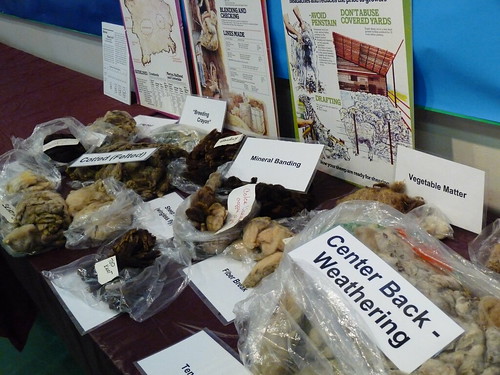
I'd seen some of these flaws before (mineral banding, vegetable matter/VM, breaks, center back weathering, cotting, leg/belly hair, breeding crayon) but had never seen bacterial staining, keds or a double coated fleece that had felted on the sheep in person before, so very very cool. They also had several excellent informational posters, my favorite being "notes on skirting":
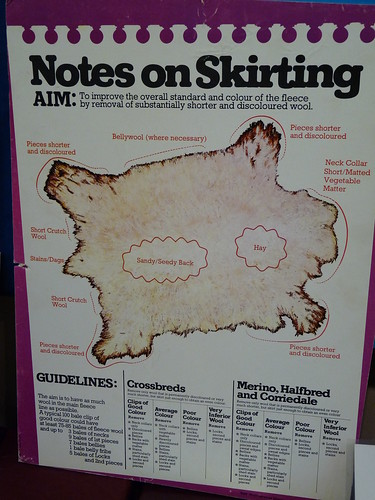
(click for big, you can read the whole thing on my flickr stream)
Others were "Notes on Belly Wool," "Notes on Preparing Short Wools," and "Notes on Preparing Sheep for Shearing."
Overall, the judging was awesome. There was a bit of a disconnect for me though, attending this as a handspinner and not as someone buying large bales of wool for commercial spinning into commercial yarn. There were several items considered for each fleece during the judging:
1. Cleanliness
2. Fiber Length
3. Fiber Strength
4. Weight
5. Uniformity of Grade (fiber diameter)
6. Adherence to breed standard (for breed category, not market/colored wool)
7. Condition, including staining, VM/2nd cuts, etc.
8. Overall character
First, I was shocked to discover that fleeces entered in the Breed judging were not discounted for cleanliness (poor shearing jobs, excessive VM, or breaks/tenderness in fleece). There were some that were rejected for sale b/c of breaks, but the idea behind not excluding external factors when judging a fleece in the breed category is that it is not the fault of the sheep and that they do not affect its adherence to the breed standard. I can't remember a VM'y fleece earning a high ribbon in the breed category judging, but still-- interesting. And you know how I love interesting :)
There was also the issue of weight... It makes sense to judge a fleece more highly if it will have less loss (vm, lanolin) if you are a handspinner or a commercial buyer paying a set price per pound and one will leave you with more clean fleece than another. However, all things being equal (including assumed loss), several times Heather and I saw fleeces that were judged to be equal with one another in all other aspects and the fleece that was heavier would place higher than the lighter one. I understand needing a "tiebreaker" but being a wool show where most fleeces will end up in a handspinner's hand and not in industry's, I think many of us would prefer a 6# fleece to a 10# one :)
Thinking on it more, it does make sense in Breed-- you could skirt down a 6# fleece to 2# and have the nicest one in the bunch with only shoulder wool. In that instance weight would help keep judging apples to apples, offering the most fleece for judging. For market/colored though-- some breeds are just larger than others and produce a heavier fleece, and would have a leg up in this category even if all were equally skirted just by fleece proportion. I don't really find it bothersome, but just interesting when you think of the higher perceived value of ribbon winners.
Any disconnect with the above in judging was more than reconciled with the last judging factor... character.
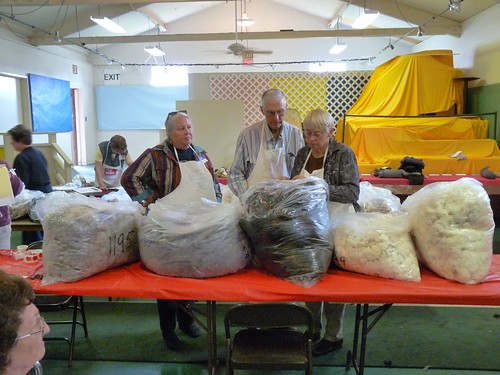
selecting grand champion from all first place finishers
I'm happy that my internal barometer of awesome is actually a valid facet of judging fleeces. Jane Patton said something to the effect that a "champion should look like a champion." I'm a sucker for the look, the touch, the way I get excited over something even though I never meant to. And goodness knows there were a lot to get excited over :)
If you're interested in attending the auction this year and haven't before, you can check out my writeup about last year's auction and what to expect. Auction attendees do not have to pay admission (it's held during the Monterey County Fair), but they are going to have a guard at gate 4 with names (if you've attended in the past, you should be on it.) If you're new, you can email Claudia Ward and she'll add you. Even if you can't attend this year but want updates about future years (or about spinning in demonstration at the fair this year), drop her a letter and let her know to add you to their mailing list. Next year they're going all electronic, no more envelopes laden with awesome stamps :)
So see you there, and don't bid against me! ;)

This was the second time I had attended a wool judging, the first was at Lambtown last year with about a third to half of the number of fleeces that were at Monterey this year. In addition to blood classes (market/white and colored wool, ranging from fine combing/64-80s down to common/40s) Monterey has judging categories for breed as well (cormo, merino, cvm, etc.). For me, I prefer the finer end of the spectrum and am lucky that there were so many excellent cormo, rambouillet and merino cross flocks in Northern California represented for me to lose it over.

Goodness. Save me.
The thing is, I went to the judging because I had NO intention of buying more fleece and probably wouldn't attend the auction this year. (I can hear you laughing from here.) I went because I wanted to learn, and did... but fell in love left and right with color and hand while my brain was being stuffed with information. (too familiar, too soon)
Attending the judging does give a different perspective on buying the fleeces at auction later; I can also see a difference in the fleeces entered this year from last. Last year I fell for one of only three true black fleeces (not the dark brown tinted black, but honest to goodness black)-- color queens like me will flip seeing several up for bid this year. There were many more entries from fewer shepherds, and there seemed to be a lot of not for sale fleeces as well (several ribbon winners were shipped on back home and won't be at the auction.)
The thinking on this doesn't make sense to me, as the auction setting would provide the highest per pound price most shepherds could likely get (and they're able to provide the starting price per pound, so it could be returned later). I also didn't understand why several fleeces that were tender/had breaks were entered into the competition at all...

The up side of buying at a wool show that is judged is that these were culled and will not be available for sale-- the buyer knows that each fleece has been gone over and most likely will be sound. It's promising since you don't always know the shepherd or don't know someone who can vouch for them and you're not able to check the soundness of the fleece for yourself. For the seller who sends in a tender fleece though-- I just can't understand the thinking of sending them (unless they don't know they had breaks). There were a lot too-- maybe 8 rejected total? Out of 150+ fleeces that's ~5%, a HUGE number to me! Especially assuming shepherds intentionally sent the best of the best.
The judging was not the place to see messy, gross, mulch-pile fleeces, but the coordinators were awesome enough to set out several samples of flawed fleeces for the attendees to check out.

I'd seen some of these flaws before (mineral banding, vegetable matter/VM, breaks, center back weathering, cotting, leg/belly hair, breeding crayon) but had never seen bacterial staining, keds or a double coated fleece that had felted on the sheep in person before, so very very cool. They also had several excellent informational posters, my favorite being "notes on skirting":

(click for big, you can read the whole thing on my flickr stream)
Others were "Notes on Belly Wool," "Notes on Preparing Short Wools," and "Notes on Preparing Sheep for Shearing."
Overall, the judging was awesome. There was a bit of a disconnect for me though, attending this as a handspinner and not as someone buying large bales of wool for commercial spinning into commercial yarn. There were several items considered for each fleece during the judging:
1. Cleanliness
2. Fiber Length
3. Fiber Strength
4. Weight
5. Uniformity of Grade (fiber diameter)
6. Adherence to breed standard (for breed category, not market/colored wool)
7. Condition, including staining, VM/2nd cuts, etc.
8. Overall character
First, I was shocked to discover that fleeces entered in the Breed judging were not discounted for cleanliness (poor shearing jobs, excessive VM, or breaks/tenderness in fleece). There were some that were rejected for sale b/c of breaks, but the idea behind not excluding external factors when judging a fleece in the breed category is that it is not the fault of the sheep and that they do not affect its adherence to the breed standard. I can't remember a VM'y fleece earning a high ribbon in the breed category judging, but still-- interesting. And you know how I love interesting :)
There was also the issue of weight... It makes sense to judge a fleece more highly if it will have less loss (vm, lanolin) if you are a handspinner or a commercial buyer paying a set price per pound and one will leave you with more clean fleece than another. However, all things being equal (including assumed loss), several times Heather and I saw fleeces that were judged to be equal with one another in all other aspects and the fleece that was heavier would place higher than the lighter one. I understand needing a "tiebreaker" but being a wool show where most fleeces will end up in a handspinner's hand and not in industry's, I think many of us would prefer a 6# fleece to a 10# one :)
Thinking on it more, it does make sense in Breed-- you could skirt down a 6# fleece to 2# and have the nicest one in the bunch with only shoulder wool. In that instance weight would help keep judging apples to apples, offering the most fleece for judging. For market/colored though-- some breeds are just larger than others and produce a heavier fleece, and would have a leg up in this category even if all were equally skirted just by fleece proportion. I don't really find it bothersome, but just interesting when you think of the higher perceived value of ribbon winners.
Any disconnect with the above in judging was more than reconciled with the last judging factor... character.

selecting grand champion from all first place finishers
I'm happy that my internal barometer of awesome is actually a valid facet of judging fleeces. Jane Patton said something to the effect that a "champion should look like a champion." I'm a sucker for the look, the touch, the way I get excited over something even though I never meant to. And goodness knows there were a lot to get excited over :)
If you're interested in attending the auction this year and haven't before, you can check out my writeup about last year's auction and what to expect. Auction attendees do not have to pay admission (it's held during the Monterey County Fair), but they are going to have a guard at gate 4 with names (if you've attended in the past, you should be on it.) If you're new, you can email Claudia Ward and she'll add you. Even if you can't attend this year but want updates about future years (or about spinning in demonstration at the fair this year), drop her a letter and let her know to add you to their mailing list. Next year they're going all electronic, no more envelopes laden with awesome stamps :)
So see you there, and don't bid against me! ;)


